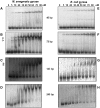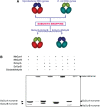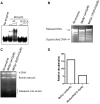Binding of two DNA molecules by type II topoisomerases for decatenation
- PMID: 22989710
- PMCID: PMC3510509
- DOI: 10.1093/nar/gks843
Binding of two DNA molecules by type II topoisomerases for decatenation
Abstract
Topoisomerases (topos) maintain DNA topology and influence DNA transaction processes by catalysing relaxation, supercoiling and decatenation reactions. In the cellular milieu, division of labour between different topos ensures topological homeostasis and control of central processes. In Escherichia coli, DNA gyrase is the principal enzyme that carries out negative supercoiling, while topo IV catalyses decatenation, relaxation and unknotting. DNA gyrase apparently has the daunting task of undertaking both the enzyme functions in mycobacteria, where topo IV is absent. We have shown previously that mycobacterial DNA gyrase is an efficient decatenase. Here, we demonstrate that the strong decatenation property of the enzyme is due to its ability to capture two DNA segments in trans. Topo IV, a strong dedicated decatenase of E. coli, also captures two distinct DNA molecules in a similar manner. In contrast, E. coli DNA gyrase, which is a poor decatenase, does not appear to be able to hold two different DNA molecules in a stable complex. The binding of a second DNA molecule to GyrB/ParE is inhibited by ATP and the non-hydrolysable analogue, AMPPNP, and by the substitution of a prominent positively charged residue in the GyrB N-terminal cavity, suggesting that this binding represents a potential T-segment positioned in the cavity. Thus, after the GyrA/ParC mediated initial DNA capture, GyrB/ParE would bind efficiently to a second DNA in trans to form a T-segment prior to nucleotide binding and closure of the gate during decatenation.
Figures







Similar articles
-
What makes a type IIA topoisomerase a gyrase or a Topo IV?Nucleic Acids Res. 2021 Jun 21;49(11):6027-6042. doi: 10.1093/nar/gkab270. Nucleic Acids Res. 2021. PMID: 33905522 Free PMC article. Review.
-
Topoisomerases I and III inhibit R-loop formation to prevent unregulated replication in the chromosomal Ter region of Escherichia coli.PLoS Genet. 2018 Sep 17;14(9):e1007668. doi: 10.1371/journal.pgen.1007668. eCollection 2018 Sep. PLoS Genet. 2018. PMID: 30222737 Free PMC article.
-
Topoisomerase IV, not gyrase, decatenates products of site-specific recombination in Escherichia coli.Genes Dev. 1997 Oct 1;11(19):2580-92. doi: 10.1101/gad.11.19.2580. Genes Dev. 1997. PMID: 9334322 Free PMC article.
-
Different propensities for gate opening in gyrases and topoisomerase IV.Nucleic Acids Res. 2025 Apr 22;53(8):gkaf330. doi: 10.1093/nar/gkaf330. Nucleic Acids Res. 2025. PMID: 40304180 Free PMC article.
-
The mechanism of negative DNA supercoiling: a cascade of DNA-induced conformational changes prepares gyrase for strand passage.DNA Repair (Amst). 2014 Apr;16:23-34. doi: 10.1016/j.dnarep.2014.01.011. Epub 2014 Feb 22. DNA Repair (Amst). 2014. PMID: 24674625 Review.
Cited by
-
Gyrase and Topoisomerase IV: Recycling Old Targets for New Antibacterials to Combat Fluoroquinolone Resistance.ACS Infect Dis. 2024 Apr 12;10(4):1097-1115. doi: 10.1021/acsinfecdis.4c00128. Epub 2024 Apr 2. ACS Infect Dis. 2024. PMID: 38564341 Free PMC article. Review.
-
What makes a type IIA topoisomerase a gyrase or a Topo IV?Nucleic Acids Res. 2021 Jun 21;49(11):6027-6042. doi: 10.1093/nar/gkab270. Nucleic Acids Res. 2021. PMID: 33905522 Free PMC article. Review.
-
Recent Progress and Challenges for Drug-Resistant Tuberculosis Treatment.Pharmaceutics. 2021 Apr 21;13(5):592. doi: 10.3390/pharmaceutics13050592. Pharmaceutics. 2021. PMID: 33919204 Free PMC article. Review.
-
Boldine-Derived Alkaloids Inhibit the Activity of DNA Topoisomerase I and Growth of Mycobacterium tuberculosis.Front Microbiol. 2018 Jul 24;9:1659. doi: 10.3389/fmicb.2018.01659. eCollection 2018. Front Microbiol. 2018. PMID: 30087665 Free PMC article.
-
Genome-wide mapping of Topoisomerase I activity sites reveal its role in chromosome segregation.Nucleic Acids Res. 2019 Feb 20;47(3):1416-1427. doi: 10.1093/nar/gky1271. Nucleic Acids Res. 2019. PMID: 30566665 Free PMC article.
References
-
- Filutowicz M. Requirement of DNA gyrase for the initiation of chromosome replication in Escherichia coli K-12. Mol. Gen. Genet. 1980;177:301–309. - PubMed
-
- Masse E, Drolet M. Relaxation of transcription-induced negative supercoiling is an essential function of Escherichia coli DNA topoisomerase I. J. Biol. Chem. 1999;274:16654–16658. - PubMed
-
- Zechiedrich EL, Cozzarelli NR. Roles of topoisomerase IV and DNA gyrase in DNA unlinking during replication in Escherichia coli. Genes Dev. 1995;9:2859–2869. - PubMed

